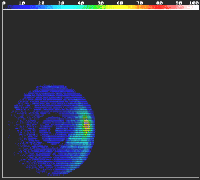In the field, when C-Scans are done for special cases, the C-Scans do not give us geometric description or geometric placement or crack/ware grove within the solid steel pins. Since the speed of sound if constant within a homogeneous steel pin the time can be directly related to the depth.

Image of a C-Scan of a Steel pin, showing a crack. The scale above indicates amplitude.